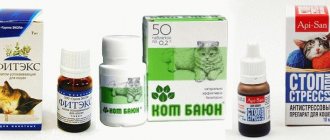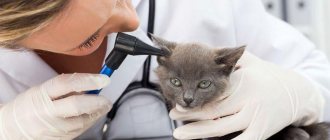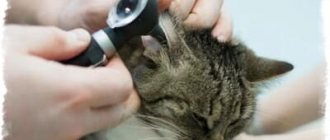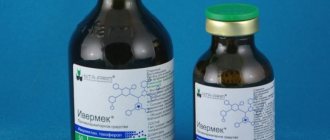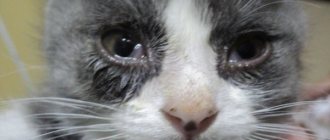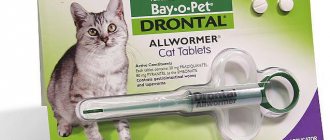If your indoor cat is clearly bothered by his ears, the most likely cause of the discomfort may be otodectosis, which is caused by mites. In this case, the pet requires immediate help. Infection with ear parasites dramatically reduces the quality of life of an animal and can even lead to its death. You will learn how to identify the symptoms of the disease and what medications to successfully treat it from our article.
What mites look like in cats' ears, photo
You can get an idea of what ear mites look like in cats from common photos and descriptions of the parasite. Therefore, if the first similar symptoms appear, the animal should be carefully examined. It is advisable to take him to a veterinarian who can make an accurate diagnosis.
It is also quite possible to detect a bug on your own. It has an oval body of microscopic size (up to 0.6 mm) of a yellowish tint, 8 limbs and 2 pedipalps. In most cases, the parasite is found in the animal's ear folds.
This is interesting: ear mites are very tenacious. While waiting for its prey, it can go without food for just over two months. And if he does not find a “carrier” during this time, he will die.
Symptoms of otodectosis
To determine whether a pet has been infected with a parasite, it is necessary to conduct a full diagnosis of its behavior and condition as a whole.
The first signs of otodectosis are:
- Anxiety. Due to the incessant itching, the cat may begin to behave aggressively.
- Scabies. The animal tries to ease the discomfort. It will rub against hard surfaces, shake its head, or scratch its ear with its paw. The danger is that as a result, scratches form on the inside of the ear. Subsequently, they become infected and begin to fester. This should not be allowed, because it can lead to the death of the pet.
- Swelling. Associated with a large accumulation of blood in the areas affected by the tick.
- Exudate - liquid discharge on damaged areas. Subsequently, mixing with particles of the epidermis and waste products of the insect, they transform into brown scabs. Often accompanied by otitis media.
- Lethargy of the animal associated with an increase in body temperature.
- A crust in the area of the ear canal, resulting in the formation of plugs of dried sulfur.
- Fur glued together with pus.
- A specific unpleasant odor that can spread to the affected area.
- Hearing impairment in later stages.
- "Bowheadedness." The cat constantly turns its head 120 degrees so that the affected ear is located below.
Important: if you find that your pet periodically has nervous attacks, contact a specialist immediately. In this case, there is a high probability that the pathogen will penetrate into the inner ear and begin the process of inflammation of the meninges.
Diagnosis and differential diagnoses
The diagnosis is made based on the animal's clinical symptoms (head shaking, itching in the ears or body, the presence of crusts in the ears) and the results of microscopy of exudate from the external auditory canal. Under a microscope, both adult ticks and tick eggs are clearly visible.
You may also need an otoscopy - examining the eardrum using a special instrument (otoscope) to check for damage. Sometimes a bacteriological or cytological examination is required - when otodectosis is complicated by otitis, it is important to determine the pathogen causing inflammation (it can be a bacterium or fungus); Then, based on the results, ear drops containing an antibacterial and/or antifungal component are selected.
Veterinarian performing otoscopy
When conducting diagnostics, the root cause must be excluded:
- Bacterial or fungal otitis
- Allergic otitis (food allergic reaction to dietary components)
- Ceruminous otitis (inflammation of the external auditory canal due to increased production of earwax)
- The presence of foreign objects in the ear canal (wool, blades of grass, sand, etc.).
Up
How to treat ear mites in cats: effective drugs
There are many effective drugs for treating ear mites in cats, including both store-bought medications and folk remedies.
Injections
A radical method of eliminating the problem, which only a veterinarian has the right to prescribe. Injectable preparations are highly toxic. They can cause side effects such as allergies, itching, and hair loss. The advantage of this procedure is the extermination of all types of parasites on the pet’s skin. For example, Doramectin (Dectomax, Doramek), Otodectin are used.
Ointments
Ointments based on acaricides help cope with the disease.
The following have proven themselves to be good:
- Amidel-gel. Not suitable for treating the inflamed area in animals at the recovery stage, kittens under 2 months of age. The composition includes: acaricide, analgesic, antimicrobial component, wound healing substances.
- Aversectin ointment. It is not recommended to treat the ears of animals with individual intolerance to the active ingredient - Aversectin, kittens, pregnant and lactating, and convalescent “patients”. Requires additional use of Perhydrol or specialized lotions to remove “crusts” from the ear.
- Ivermec-gel. Contraindicated for breeds sensitive to the active substance, as well as convalescent and depleted representatives of the cat family. Contains an analgesic - lidocaine hydrochloride. Additionally, it has a wound-healing effect.
To achieve the result, you need to clean the animal’s ears, apply the drug to the affected area, fold the auricle in half and do a light massage.
Caution: when using internal medications (drops), you must strictly follow the dosage indicated in the instructions. Otherwise, the poisons, having accumulated, will poison not only the parasites, but also the animal itself.
Drops
One of the most effective and simple methods of dealing with ticks is the use of drops. Their range is distinguished by a fairly wide range of drugs, which allows you to choose the most suitable one for both the kitten and the “mother” during lactation.
The rating of highly effective ear drops includes:
- Surolan. Not recommended for use when the drum membrane is perforated. Contains antimicrobial and antimycotic complexes. Has an anti-inflammatory effect. The frequency of instillation is once every 2 weeks.
- Aurikan. The main substance is the insecto-acaricide Diazinon, which also contains an antiseptic and analgesic. The drug additionally helps to minimize the inflammatory process. For the first week, the auricle is treated daily, then every 3 days.
- Amitrazine. A drug based on a composition of acaricides Amitraz and Dimexide. Repeated treatment is carried out a week after the first procedure.
- Ectodes. Requires preliminary cleaning of the ear canal. This drug is based on propolis and sulfur. Among the contraindications: lactation period, age up to 1 month, violation of the integrity of the tympanic membrane. Frequency of use: every 5-7 days.
- Anandin "+". Consists of Permethrin, Gramicidin and the immunostimulant Anandin. Hearing therapy lasts up to 7 days. If you miss at least one day, treatment starts again.
- Amit. Designed for soaking crusts using a cotton pad twice a day. Course duration is up to 5 days. Contains Prednisolone and Amitraz. If a secondary infection occurs, the product should be replaced. Not recommended for kittens under 2 months, cats during lactation, and mated animals.
- Decta. Contraindications are standard. Frequency of use: once every 3-5 days. Consists of Amitraz, Dexamethasone. Supplemented with propolis.
- Dana. Drops are presented in the form of pipettes. The active ingredient is Diazinon. After the procedure, a light massage is recommended. Requires repetition of actions after a week.
- Mycodemocid. The product contains isopropyl alcohol detergent, sea buckthorn oil, chlorophos. If necessary, the treatment is repeated after 7-8 days.
Sprays
An important advantage of sprays is ease of use. In addition to your pet's fur, you can additionally treat the animal's bedding with the drug. This is done to prevent re-infection.
Among the common products of this type, Ivermec spray is widely in demand. It is recommended to spray it in the ear area a couple of times a day at intervals of 3-5 days.
Advice: you can prevent animals from licking any medicinal composition by wearing an “Elizabethan” collar (veterinary cone) before it dries.
Folk remedies for black plaque
It is not always possible to use purchased medications at the first stage of tick infestation. In this case, you can use home remedies. They are allowed in the absence of severe mechanical damage from claws, coagulated blood and blackness.
Mineral oil
An excellent tool that allows you to exterminate the parasite and dissolve the dense crust that has formed. To achieve the goal, you need to use enough product so that it evenly covers the inner ear. Oil therapy lasts 2-3 weeks, on the 5th day the ticks should leave their hiding places.
White vinegar
Dilute the product in equal proportions with water. Place a few drops of vinegar in each ear. At the end of the procedure, the inner surface should be wiped with a cotton pad. Do not use the product on cats that have wounds on their skin.
Why is the disease dangerous?
Ear mites consume particles of the epidermis, which severely damages the skin. If treatment is not started on time, the disease will lead to dangerous consequences for health:
- suffering from unbearable itching, the animal sometimes scratches its ears until they bleed, damaging the capillaries - large hematomas appear;
- microtraumas on the skin open the way for infections, inflammation begins, the ear swells, redness and suppuration appear;
- the eardrum and inner ear become inflamed, and otitis media develops.
Delayed initiation of treatment leads to hearing loss and then to hearing loss. The cat is restless and irritated, cannot fully rest due to constant discomfort, and becomes aggressive. When the disease penetrates the lining of the brain, death will occur. Ear mites are dangerous because they are quite difficult to recognize, hence the frequency of advanced cases when it is very difficult to save the animal.
Rules for cleaning ears at home
Before carrying out the procedure, be sure to clean your cat's ears. This must be done regardless of the drug used, even if there is no such indication in the instructions for it.
As tools you will need:
- cotton pads to remove plaque;
- cotton swabs (it is not recommended to use homemade devices in the form of cotton wool wound around a match, this can cause damage if you are careless);
- cleaning agents (chlorhexidine, hydrogen peroxide, boric acid solution at a concentration of 3%).
Advice: if your pet is not accustomed to this kind of event or has an intractable character, arm yourself with a towel or sheet in which to swaddle the animal.
The sequence of the procedure for cleaning a pet's ears:
- Place the cat on your lap after covering it with a blanket. Calm down. Remember that for the animal, your desire to cure it is still perceived as a stressful situation.
- Gently bend the auricle and wipe the surface from dirt.
- Gently clean the affected area with a cotton swab soaked in a disinfectant solution. Never pick an animal's ear with pressure.
- Apply the drug. Massage lightly.
- Give the cat a chance to shake its head. Afterwards, wipe the inside of the ear and the hair around it with the same composition.
Prevention
The appearance of ticks is a case more typical for “walking” animals. However, even if your pet has never left the walls of the house, this does not guarantee that you will not encounter the disease. The reason may be the use of other people's carriers, bedding or toys.
Preventive measures include:
- regular ear cleaning (Bars Lotion, Otifri, Otodepin are excellent);
- preventing contact with stray animals;
- periodic disinfection of paraphernalia (beds, bowls, etc.);
- strengthening the immune system (it is recommended to include foods high in microelements and vitamins);
- the use of special drugs during the period of parasite activity.
Give your furry friends more attention, which is expressed not only in affection and feeding. Do not forget that they, like any living organism, require care. After all, when the animal receives it at the proper level and is in a calm state, then the owner is happy. Good luck!
Causes of exacerbation of demodicosis
- various types of dermatitis;
- weakened immune system;
- acne;
- skin infections;
- HIV;
- gastrointestinal diseases.
To treat the disease, you must consult a doctor. Self-medication in this case is evil. The doctor will conduct an appropriate study and prescribe adequate therapy.
